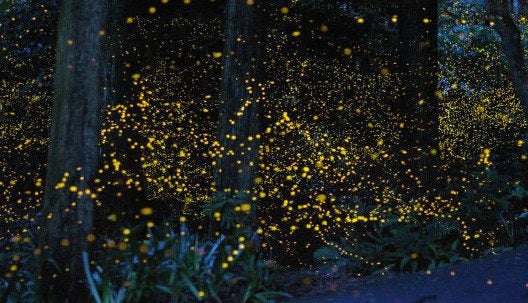
Fireflies are the only species in North America that can synchronize their flashing light patterns; through a new project, bicyclists are soon to be the second.
The Kuramoto Model (1000 Fireflies) is a community-wide art piece by David Rueter, an MFA candidate in Art and Technology Studies at the School of the Art Institute of Chicago. Through this project, 1000 flashing LEDs will be distributed to bicyclists who attend Northern Spark, an all-day, city-wide arts festival in Minneapolis. Riders will participate in a midnight ride on June 9 when the safety LEDs will sync up, resembling fireflies dancing in the night.
The project will perform the cooperation and unity of the urban social network, especially as it applies to the cycling community. The synchronization will highlight cycling as a system with unique patterns and effects while transforming the system momentarily through a large-scale community ride/ performance piece. We are big fans of Reuter's project, both for its focus on unity built from the individual and the possibilities of perception. Also, we imagine making 1000 flashing lights is no easy task. See the process in closer detail on Reuter's blog. Scroll down for our interview with Rueter on the project.
HP: How did you come up with the idea for 1000 Fireflies?
DR: Jan Tichy, the artist behind Project Cabrini Green (an LED-based light installation that addressed the demolition of the former housing project) and a mentor of mine, got me thinking about the possibilities of large numbers of digitally controlled lights. I wanted to make something dynamic and interactive on the scale of a whole city, encouraging of participation and new ways of relating to others, and integrated with existing social networks.
It all came together when yet another great mentor sent me a call for public art proposals for Minneapolis's dusk-to-dawn arts festival, Northern Spark. After struggling with the problem of how putting electronic badges on people might become contrived or problematic, one morning I realized that many cyclists already wear lights, to some degree already identify with one another, and would be eager to participate.
HP: How will you synchronize the LED lights, exactly?
DR: The lights synchronize using radio communication and a relatively simple strategy of broadcasting, listening, and adjusting. Each one has its own independent rhythm, but each constantly tries to adjust to what it hears from others. If it hears another broadcast early in its cycle, it slows down a little bit so that next time the other one won't be late. The most interesting part of this is that this strategy also works for large groups and that no leader is required: the group is entirely self-organizing. There’s a lot of research into synchronization -- some key figures are Norbert Wiener, Art Winfree, Yoshiki Kuramoto, and Steven Strogatz. Strogatz gave a great TED talk on the subject, which I highly recommend. This kind of lateral self-organization is politically significant in the context of the project: the social structures that make automobile travel possible are fundamentally hierarchical, and in many ways the bicycle is a much more decentralized approach to transportation.
HP: Where do you look for guidance on urban social behavior?
DR: Most recently I've been learning a lot from organizers I’ve been working with, including the people at Northern Lights.mn, as well as members of various bike-related nonprofits and community organizations. It seems that the best organization is not really about trying to control people’s behavior; it’s about structuring the playing field so that interesting things are more likely to happen.
In terms of artistic practice and theory, the Situationist International, Fluxus, and Nicolas Bourriaud’s writing have all shaped my thinking about how artistic practice can weave itself into an urban social environment and disrupt the standard ways people relate to one another and the space of the city. I like to think that I’m making a kind of social interstice, and that something like Guy Debord’s dérive might simultaneously play out for thousands of people in Minneapolis on June 9.
HP: We love any opportunity to blur the line between art and science. Do you see these as two separate disciplines and how do you envision them interacting?
DR: In some ways this project is a big experiment, but it's very different from a scientific experiment in that I have no hypothesis, and don't expect to gain any concrete knowledge as a result. I’m interested in creating a diverse collection of individual experiences and encounters. That’s much more nebulous than something a scientist would want to pursue. I do hope, though, that in the same way that the science of synchronization has inspired me, this project might spark the imaginations of others, scientists included.
Visit the Kickstarter page for The Kuramoto Project (1000 Fireflies) to see how you can get involved.
Correction: In an earlier version of this article we misspelled David Rueter's last name. We apologize for the error.
